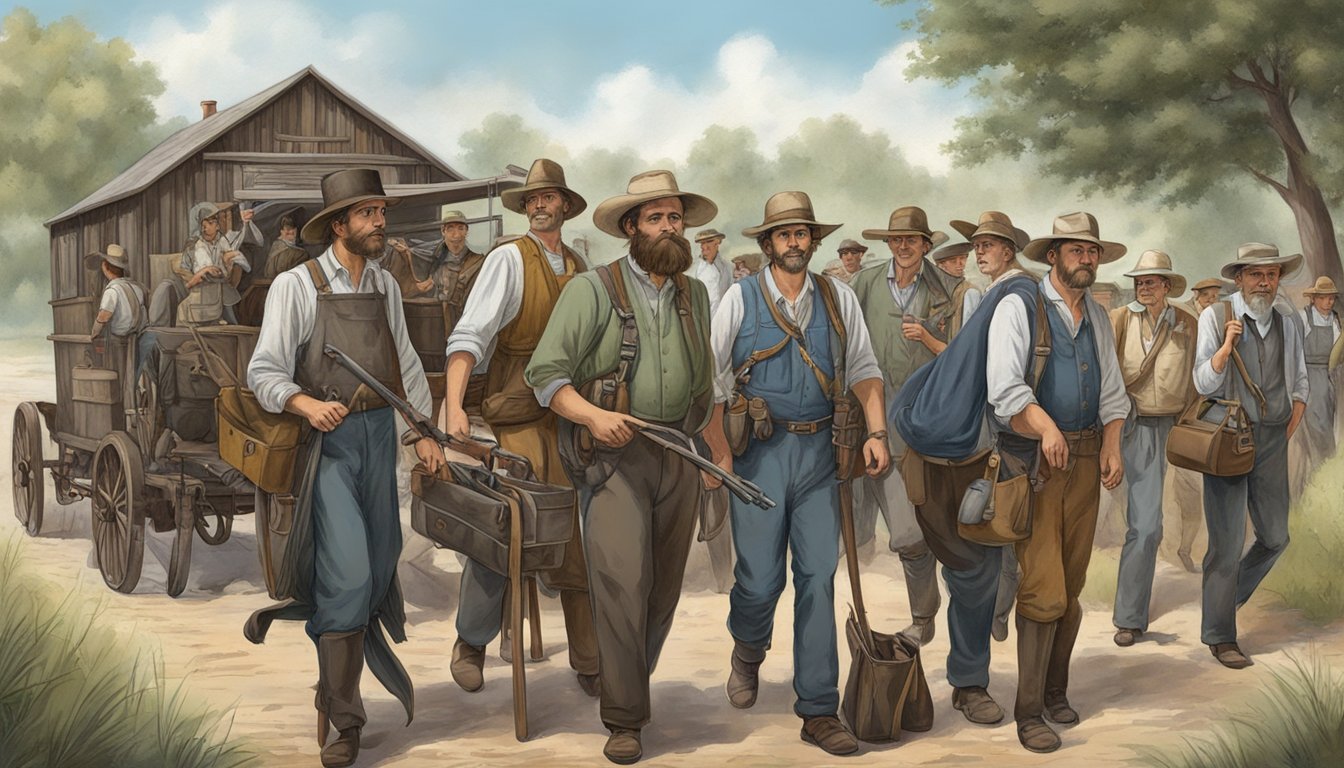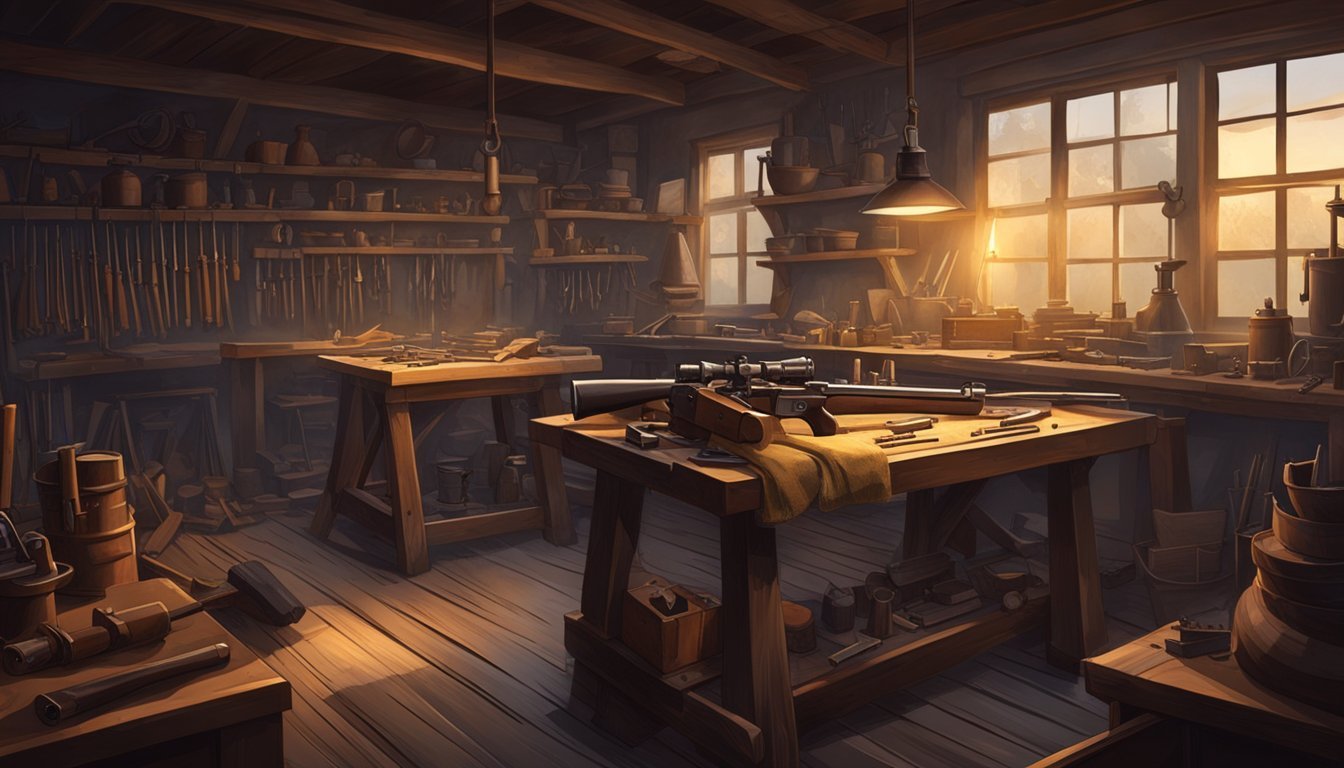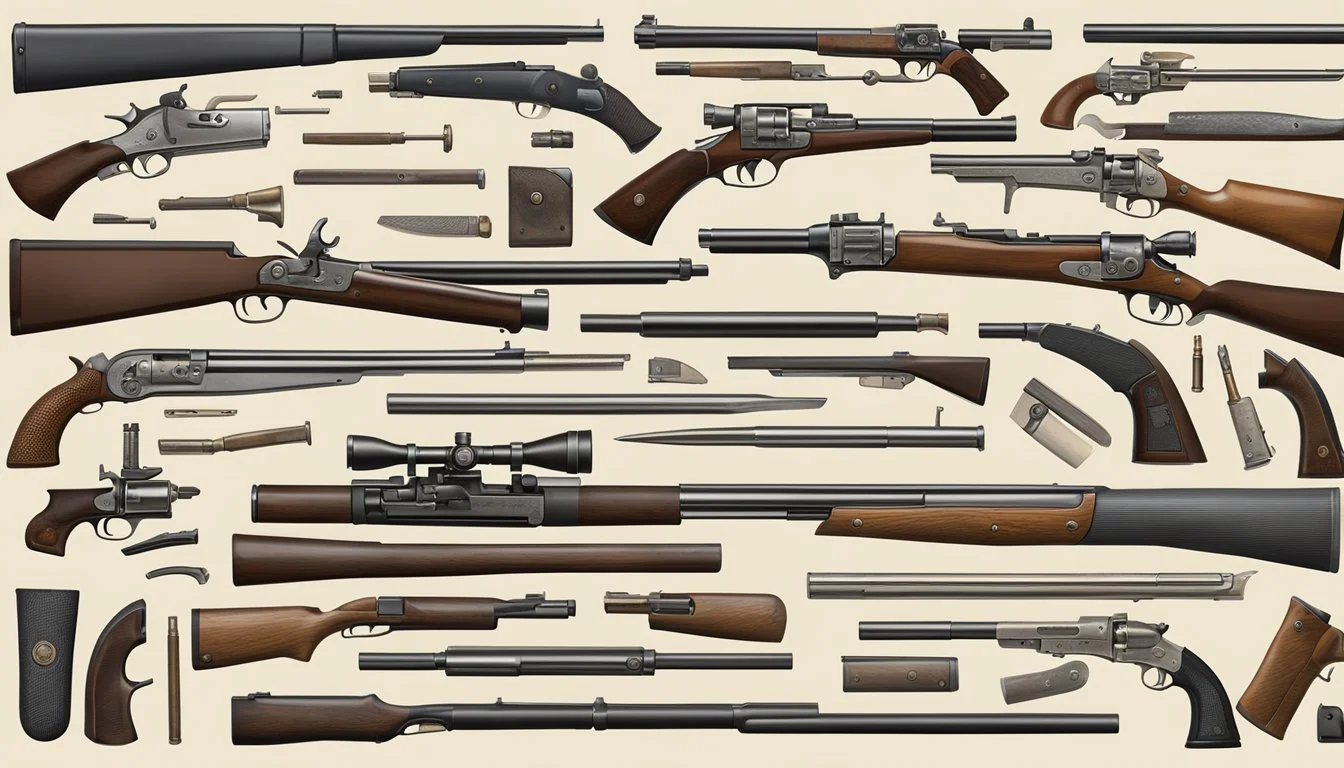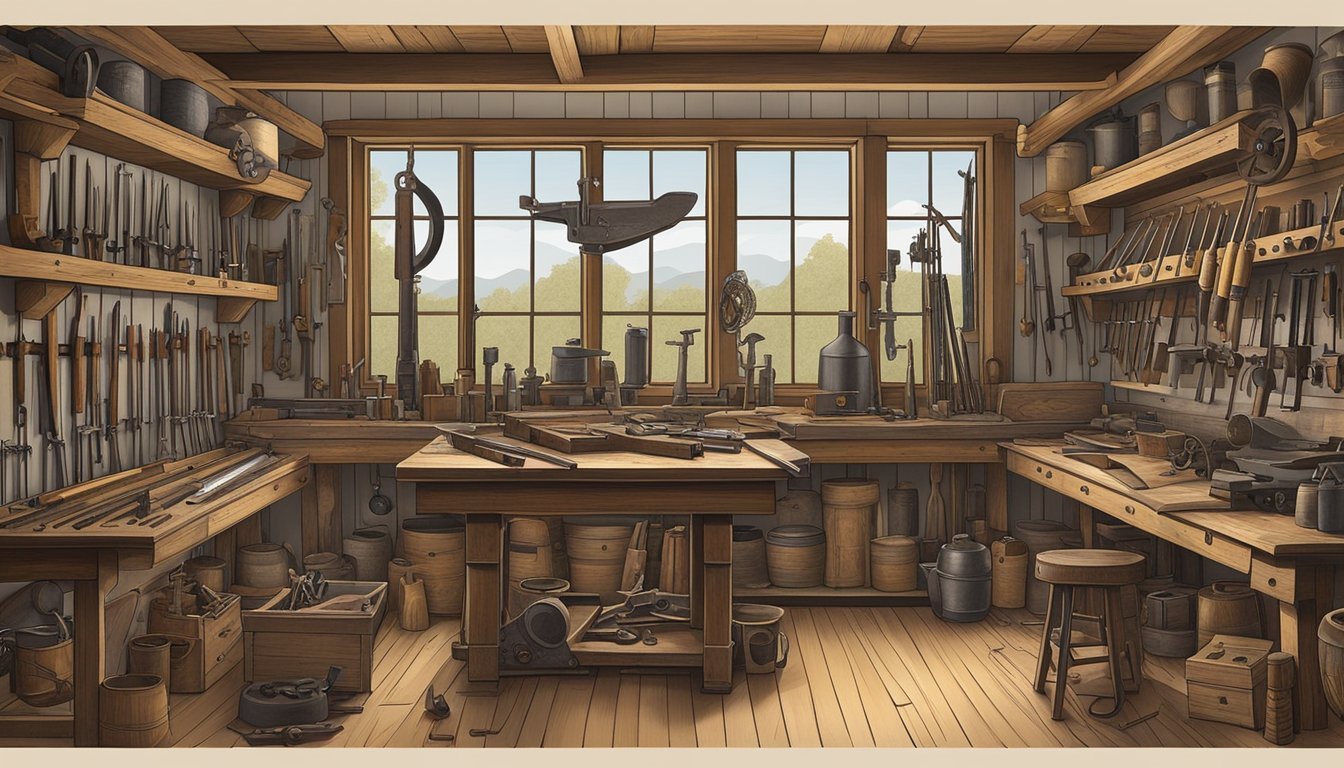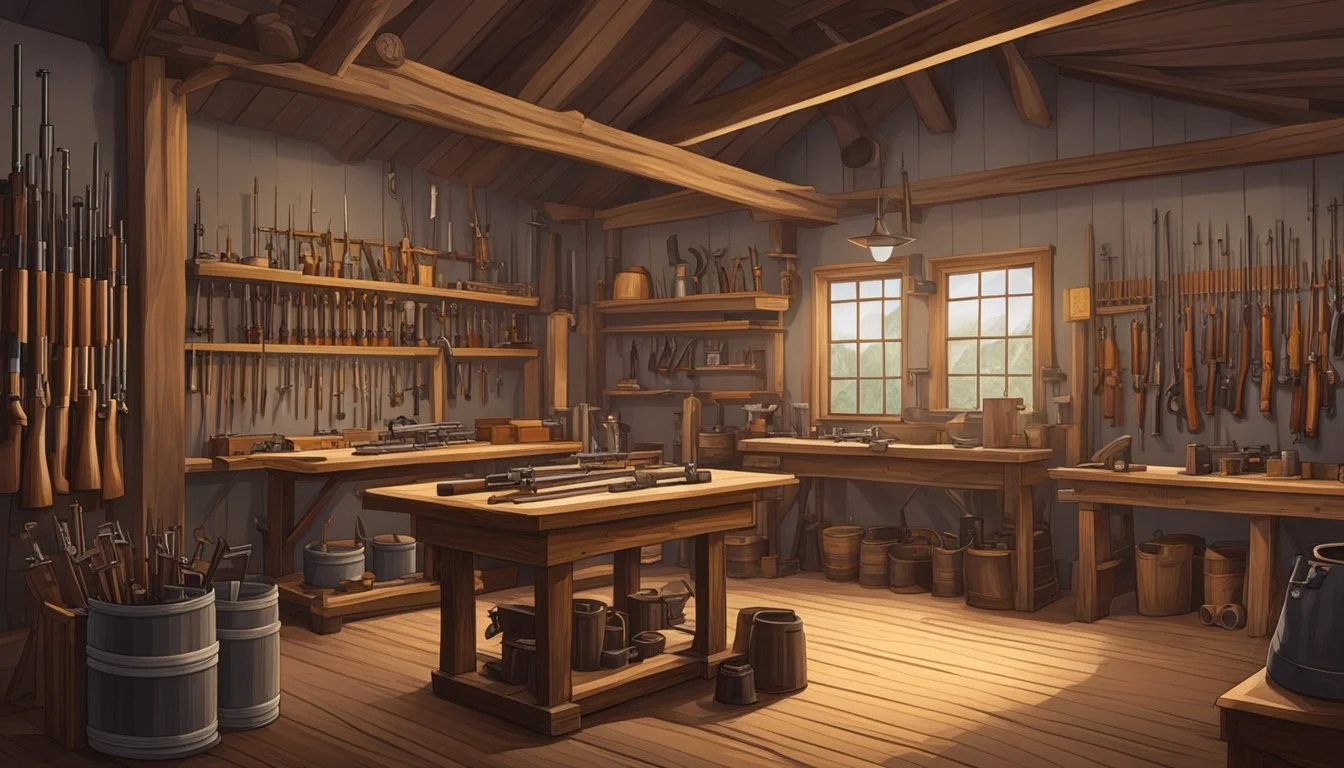The History of German Texan Gunsmiths and Firearms Makers
Craftsmanship and Legacy
The rich tapestry of firearms history is significantly colored by the contributions of German Texan gunsmiths and firearms makers, whose skills and traditions have played a pivotal role in shaping the industry. German immigrants brought with them a deep-rooted knowledge of gunmaking that blended with the frontier spirit of Texas during the 19th century. Establishing shops and factories, these artisans combined the precision of German engineering with the practical needs of the American West to produce firearms renowned for both their quality and reliability.
Among the notable entities in this realm was Herbert Schmidt Ostheim, a German gunmaking company established in post-war Germany, which became widely recognized for producing models like the "Texas Scout." The company demonstrated the ability to adapt and innovate, catering to both the sporting and blank-firing replica markets. Alternatively, firms such as J.P Sauer & Sohn represent Germany's oldest manufacturer of hunting firearms with a venerable history that began long before German craftsmen set foot in Texas. This marks a continuum of excellence and innovation that German gunsmiths carried across the Atlantic.
German firearms makers have had a lasting impact on gunmaking both in their homeland and abroad. Their legacy is characterized by a relentless pursuit of perfection in craftsmanship and an unwavering dedication to functionality. The symbiosis between German skill and the environment of Texas resulted in the flourishing of a distinctive niche in the history of firearms, one where the principles of craftsmanship were preserved even as innovation was embraced to meet the evolving demands of gun users in the New World.
Early German Immigration to Texas
The significant influx of Germans to Texas in the mid-19th century laid the foundation for the enduring tradition of gunsmithing in the state, reflecting a rich history intertwined with German Texan gunsmiths.
Settlement and Integration
German immigrants began settling in Texas around the 1830s, a period when the Republic of Texas was newly formed after gaining independence from Mexico. The Adelsverein, also known as the German Immigration Company, facilitated a considerable part of this migration, aiming to establish a new Germany within Texas. By 1850, Germans constituted over five percent of Texas's population, integrating into the local society while maintaining their customs and craft traditions.
Beginnings of Gunsmithing in Texas
With their expertise in metalworking and craftsmanship, many German immigrants naturally transitioned into gunsmithing as a means to provide for their communities and practice their heritage. These gunsmiths crafted firearms that were essential for survival and defense in the frontiers of Texas. As their reputation for quality grew, German Texan gunsmiths became an integral part of the firearms industry in Texas, setting standards in gun manufacturing that persisted for generations.
Development of German Texan Firearms
German Texan gunsmiths transplanted their rich heritage of firearm design and manufacturing to Texas, adapting their time-tested techniques to the new world they settled in. They combined European craftsmanship with American innovation, profoundly impacting the local firearm culture and industry.
Adapting European Techniques
German gun makers brought with them an advanced knowledge of metalworking and precision engineering from their homeland. This included expertise in creating rifled barrels that significantly improved accuracy over smoothbore firearms. In Texas, they adapted these techniques to local materials and needs, often incorporating native woods and metals. The need for reliable firearms in the frontier environment of Texas pushed these gunsmiths to modify traditional designs for greater durability and functionality in harsh conditions.
Innovation and Craftsmanship
The craftsmanship of German gunsmiths in Texas was evident in the attention to detail and artistic skill applied to firearms production. They were known for precision and a meticulous approach to gunmaking which was visible in every weapon they crafted. Innovations introduced by these artisans often included enhancements in firing mechanisms and the integration of new materials to improve gun performance. These craftsmen not only contributed to the functional aspects of firearm development but also to the aesthetic, often embellishing firearms with intricate engravings and woodwork.
Influence of German Gunsmiths in Texas
German gunsmiths exerted a substantial influence on Texan firearms culture. Their presence in small settlements was integral to the community, providing not just weapons for defense and hunting but also contributing to the technological fabric of Texan society. They mentored local apprentices, thereby establishing a tradition of gunmaking that incorporated German precision with Texan resilience. The impact of German firearms makers extended to various aspects of life in Texas, from the effectiveness of weaponry in conflicts to the growth of a local industry centered around firearms manufacturing.
Influential German Texan Gunsmiths and Manufacturers
The German Texan community has made significant contributions to the firearms industry in Texas through formidable personalities and pioneering companies. This section explores the prominent individuals and manufacturers that left a lasting legacy in the realm of gun craftsmanship and innovation.
Iconic Personalities
German settlers brought with them a rich tradition of gunsmithing to Texas which was continued by certain influential figures. Noteworthy among them was Carl Mauser, who, with his brother Paul Mauser, played a prominent role in developing firearms technology. The Mauser rifle, known for its precision and durability, is a testament to their skill and innovative approach.
Similarly, individuals like Ludwig Loewe and Nicolaus Dreyse were integral in advancing firearm design. Loewe's contributions in manufacturing and Dreyse's invention of the needle gun greatly impacted gun-making, setting the stage for future developments.
Established Gun Manufacturing Companies
Established German gun manufacturing companies such as Heym, Merkel, Sauer, and Blaser have deep roots that trace back to Germany, but their influence has been strongly felt in the Texan firearms scene as well. Each of these companies brought with them unparalleled craftsmanship and a drive for excellence that set the standard for quality in the industry.
Heym is renowned for creating high precision rifles.
Merkel stands out for its combination of traditional craftsmanship with modern technology.
Sauer is recognized for its innovative approach to gun-making and a diverse product range.
Blaser is known for integrating ergonomic design with cutting-edge technology.
The reputation of these companies highlights the profound impact that German expertise has had on the Texan firearms industry, underscoring a legacy of precision engineering and innovation.
Firearm Types and Technology
German Texan gunsmiths have been recognized for their craftsmanship and the variety of firearms they produced. These skilled artisans integrated traditional German techniques with new technological advancements to craft firearms tailored to the needs of Texans.
Handguns and Rifles
Handguns and rifles created by German Texan gunsmiths were known for their precision and durability. Bolt-action rifles, based on the renowned Mauser 98 type actions, were a significant contribution to this category. They offered shooters reliability and accuracy, essential for both hunting and defense.
Engravings on firearms became a testament to the gunsmith's skill, transforming the weapon into a personalized work of art. The level of detail in these engravings helped German Texan firearms stand out in the marketplace.
Shotguns and Combination Guns
Shotguns crafted by German Texan gunsmiths were celebrated for their quality and balance, making them a preferred choice for hunting game. Combination guns, such as drillings and vierlings, showcased the versatility of German Texan craftsmanship. These firearms combined two or more barrels of different calibers allowing hunters to adapt to various types of game with a single weapon.
Type Description Drillings Typically incorporated two shotgun barrels and a rifle barrel for versatile hunting use. Vierlings Added an extra barrel, providing an additional caliber option for the user. Krieghoff A renowned brand among German Texan gunsmiths, known for their high-quality firearms.
Innovations in Gun Mechanisms
German Texan gunsmiths were adept at incorporating innovative mechanisms into their firearms. The design and functionality of triggers were given special attention, ensuring a smooth and clean release. Users often praised the responsive nature of these triggers during operation.
The implementation of precision engineering allowed for the consistent and reliable performance of Texan-made firearms. The integration of new technologies provided advancements in firearm mechanisms which in turn enhanced the shooting experience.
Firearm Culture and Legacy
The historic fabric of firearm culture among German Texan gunsmiths intertwines the art of gunmaking with a storied tradition of hunting and sporting. This legacy is marked by a deep respect for custom craftsmanship, a commitment to preserving heirlooms, and a contemporary revival that honors the past while embracing modern collectibility.
Hunting and Sporting Traditions
German Texan gunsmiths have long been celebrated for their production of high-quality hunting firearms. They crafted guns that were not only functional tools for settlers and frontiersmen but also works of art that reflected their mastery of the craft. Hunting was, and still is, an integral part of life, with firearms playing a crucial role in these rituals. From the chased game in the Texan wilderness to the precision required in sporting competitions, German-made firearms have been lauded for their accuracy, durability, and custom features.
Firearms as Heirlooms
Firearms crafted by German Texans often transcended their practical use; they became treasured family heirlooms, passed down through generations. Each weapon often bore distinctive custom features, such as engraving and inlay work that reflected the owner’s personal story or heralded the maker's signature style. These firearms were not just tools of sustenance or defense but were emblematic of family lore and heritage. As such, they hold profound sentimental value and serve as physical repositories of family history.
Modern Resurgence and Collecting
Today, there is a resurgence of interest in the firearms industry that admires and seeks the work of historic German Texan gunmakers. Collectors and historians alike hunt for these storied pieces, which echo the battle-hardened paths of their original bearers and the peaceful woods and fields that tested their mettle in the hunt. The tradition of collecting and the appreciation for the craftsmanship of German Texan firearms remain strong, as enthusiasts look to preserve the lore and legacy embedded in each handcrafted piece.
Techniques and Craftsmanship
German Texan gunsmiths have long been recognized for their meticulous techniques and superior craftsmanship. Their work is characterized by a tradition of precision and a dedication to creating both functional and beautiful firearms.
Barrel Making and Engravings
Barrel making is a critical component of firearm construction and German Texan gunsmiths are noted for their sophisticated methods in this area. They employed rigorous hand-forging techniques to create barrels that were both durable and accurate. The incorporation of black powder in the design of firearms necessitated expertise in ensuring the safety and reliability of the barrels.
Utilizing fine tools, gunsmiths added intricate engravings to their firearms, which often reflected the identity of the owner or the gunsmith's own signature style. The engravings served not only as a mark of craftsmanship but also denoted the firearm's uniqueness.
Innovation: Integration of new barrel-making techniques to improve accuracy.
Guilds: Establishment of standards and the sharing of advancements amongst guild members.
Barrel Making: Hand-forging methods that ensured strength and precision.
Engravings: Customized markings that showcased the gunsmith's artistry.
Customization and Functionality
German Texan gunsmiths held reputations as pioneers in the customization of firearms to meet the specific needs of their users. They were adept at modifying stock designs to improve the overall functionality of a weapon, ensuring that it met the precise requirements for comfort and purpose.
Custom features, such as specialized triggers and tailored grips, enhanced the shooting experience and provided a personalized touch. The gunsmiths struck a balance between artful aesthetics and practicality, highlighting their dual commitment to form and function.
Customization: Tailoring weapons to individual preferences and needs.
Functionality: Balancing aesthetics with enhancements in performance and ergonomics.
Innovation: Continuously refining methods to incorporate custom features without compromising the firearm's integrity.
Impact on the Firearms Industry
The German Texan gunsmiths contributed to essential changes in firearm manufacturing and adapted to industry demands, ensuring their survival and evolution within the firearms industry.
Changes in Manufacturing
They introduced precision engineering and craftsmanship that set new standards in the production of firearms. Innovations brought forth by German Texan gun makers were evident in both the materials used and the manufacturing techniques employed. They were pivotal in transitioning the industry from handcrafted individual pieces to more standardized, mass-produced firearms. This shift not only increased production rates but also brought significant changes to prices and market accessibility.
Manufacturers and guilds also played a crucial role in shaping the firearms industry. Through the establishment of stringent guild rules, the quality of guns remained high, which further solidified their reputation in the global market.
Adaptation and Survival
German Texan firearm makers demonstrated their resilience by adapting to the fluctuating demands of the firearms industry. They were quick to adopt new technologies and were skilled in diversifying their product range to include sporting and hunting rifles, in addition to the standard military-issue firearms. This adaptability allowed them to endure economic challenges and maintain relevancy within the industry.
The flexibility of these gun makers in responding to changes did not only secure their survival but also helped propel the industry forward. They were among the leaders in integrating new mechanical methods into their manufacturing processes, a move that resonated throughout the industry, influencing other manufacturers and setting a precedent for quality and innovation.
Regulation, Trade, and the Market
In 19th century Texas, German Texan gunsmiths operated within a complex framework of regulation and market forces. The intricate balance of gun laws, guild traditions, and the economics of gunsmithing shaped their craftsmanship and trade practices.
Gun Laws and Guilds
Gunsmiths in Texas navigated an evolving landscape of regulations. Regional legislation impacted the production and sale of firearms. They adhered to the laws that governed not only the possession but also the manufacture of guns. The influence of European guilds carried over with German immigrants, who often brought the structured approach of rigorous training and certification. These guilds enforced quality control, adherence to established techniques, and the sharing of advancements within the trade.
Guild Membership: It was common for gunsmiths to be part of guilds that dictated certain aspects of their trade, ensuring a standard of quality and regulating competition.
Legal Compliance: They monitored legislation to stay compliant with state and federal laws concerning the gun trade.
The Economics of Gunsmithing
The economic viability of gunsmithing depended on various factors. The demand for firearms and the availability of materials influenced gunsmiths’ business operations. While some gunsmiths and gun dealers thrived by catering to a growing population of settlers and traders, others had to adapt to economic fluctuations and shifts in supply and demand.
Resources and Trade: Essential materials were often scarce, necessitating trade networks. They sometimes needed to import materials or parts from other states or even from Europe.
Craft and Commerce: Successful gun shops balanced the craft of gunsmithing with savvy business practices. Pricing structures and business models were adapted to the regional economic climate and customer base.
German Texan gunsmiths were significant in shaping both the tradition and the market for firearms in the region, maintaining European standards while adapting to the unique challenges of the Texan frontier.
Conclusion
The history of German Texan gunsmiths and firearms makers is indicative of a rich legacy of craftsmanship and cultural influence. German immigrants applied their in-depth knowledge and traditional techniques to the development of firearms in Texas, showcasing a commitment to quality and innovation.
Legacy: These artisans left a significant mark on the regional history of firearms manufacture, merging German precision with Texan needs. Their contributions continue to be recognized in today's firearm collections and historical commemorations.
Craftsmanship: The skill of German Texan gunsmiths is evident in the details of each firearm. The enduring functionality and design of their weapons underscore a profound understanding of gunsmithing.
Cultural Integration:
Firearms imbued with German aesthetics
Incorporation of local materials and styles
Adaptation to the burgeoning frontier market
German Texan gunsmiths not only adjusted to a new environment but also enriched the local gun manufacturing scene with their expertise. Their legacy extends beyond the guns they crafted, influencing modern practices and maintaining historical relevance in the broader narrative of Texas.


